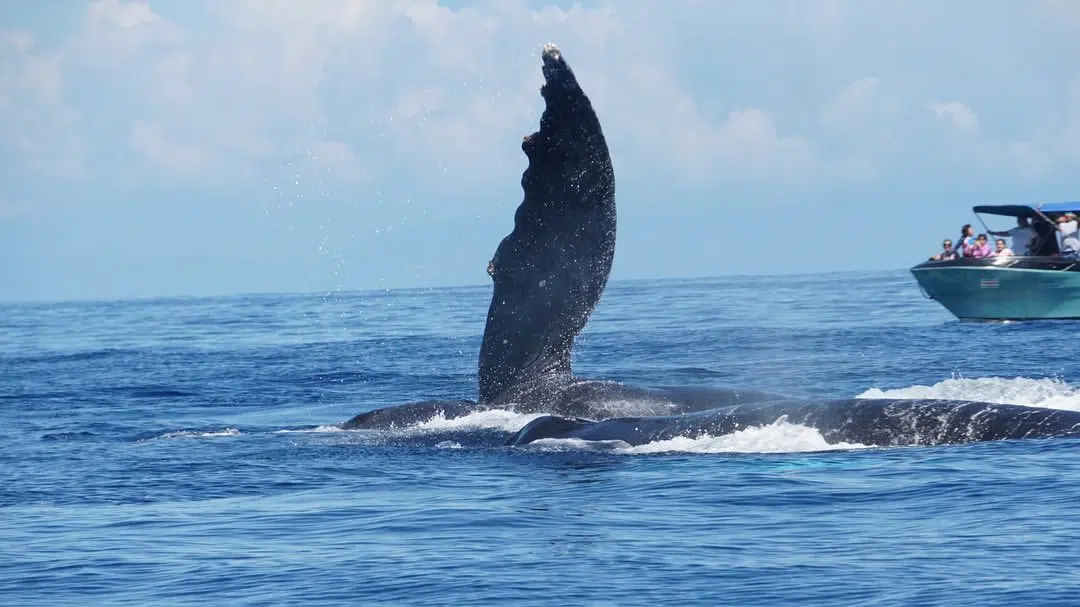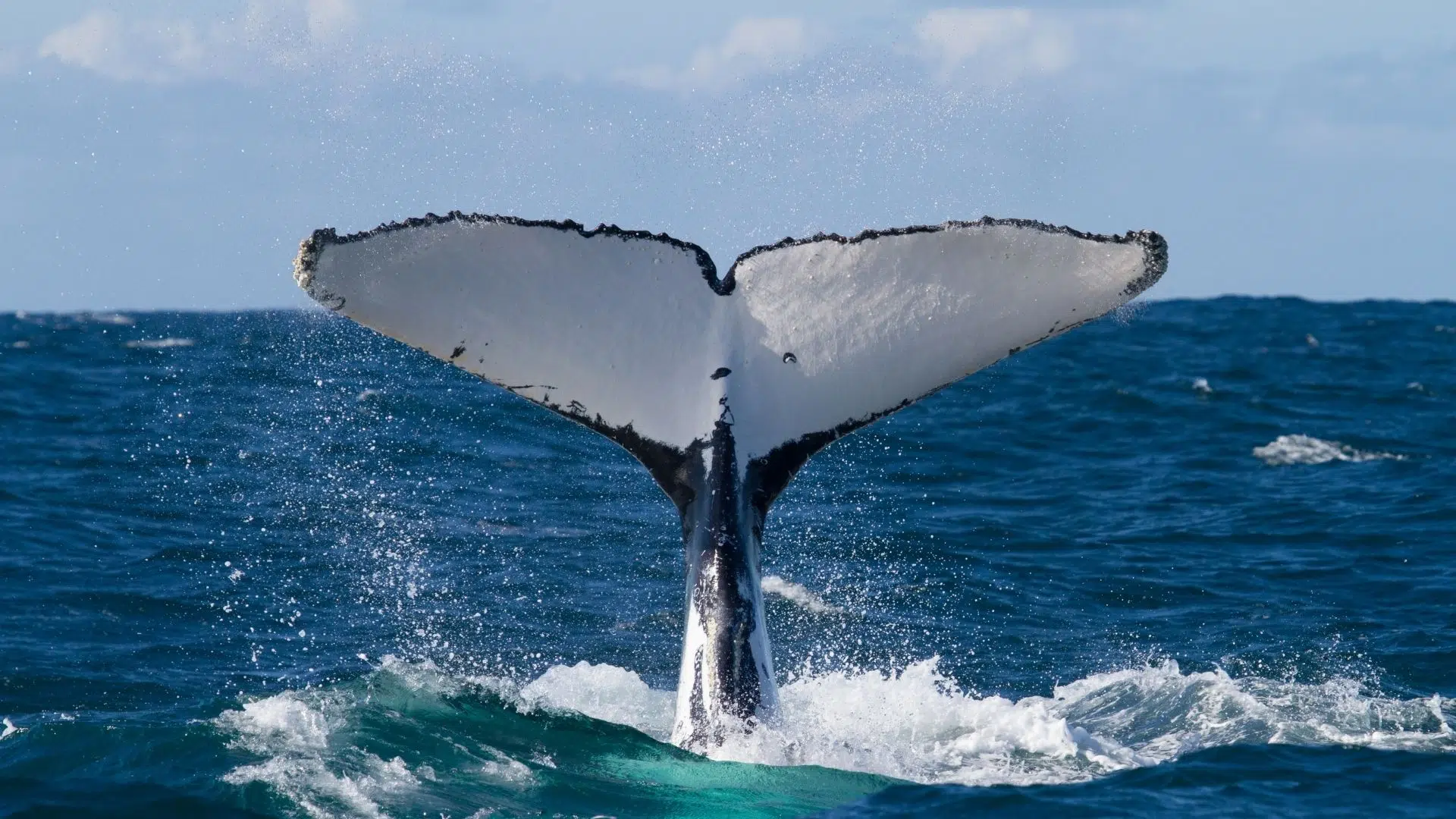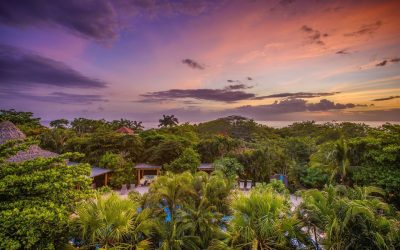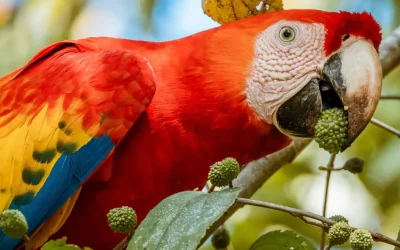As birds look for warmer temperatures during winter, humpback whales navigate the tropical waters of the Pacific Ocean to enjoy warm tropical waters. Watching these magnificent creatures on their journey can be a once-in-a-lifetime experience that helps you appreciate marine life’s beauty and diversity.
With its location in the heart of Central America, stunning beaches, and lush greenery, Costa Rica sets the perfect stage for this breathtaking show. Would you like to see humpback whales gracefully navigating through Costa Rican waters? We’re about to tell you the best spots and the best time for whale watching in Costa Rica!

Where is the Best Place to Watch Whales?
There are many places in Costa Rica where you can go whale-watching. However, one stands out the most for having the best conditions to witness humpback whales during their migration. Let’s get into the details.
Uvita and the Marino Ballena National Park
Located on the South Pacific Coast, Uvita is the go-to spot to witness these magnificent creatures. This charming town has the longest humpback whale season in the country, meaning that you can spot whales here year-round as they migrate north and south. So, no matter when you visit, there’s a good chance of seeing these incredible creatures.
The Marino Ballena National Park, located in Uvita and the first of its kind in Costa Rica and Central America, was created to protect the beautiful waters and diverse marine life.
According to SINAC (National System of Conservation Areas in Costa Rica), alongside northern hemisphere and southern antarctic humpback whales, you can find other fascinating marine animals like:
- Spotted dolphins.
- Bottlenose dolphins.
- Manta rays.
- Hammerhead sharks.
- Parrotfish.
- Mackerel.
Marino Ballena National Park has something really cool called the Whale’s Tail sandbar. This special rocky and sandy location forms when tides bring in sediment. To see the tail shape, the tide must be low, and you must head to higher areas to fully appreciate it.
To learn more about whale sightings in Marino Ballena National Park, check out our tour, where you’ll depart from Manuel Antonio and head south along the coast toward Uvita.
Osa Peninsula
Observing aquatic wildlife is very popular on Costa Rica’s South Pacific Coast, especially on the Osa Peninsula.
This region boasts three whale species, including humpback whales, pilot whales, and pseudo-orca whales, making it a must-visit for whale enthusiasts. There are also bottlenose dolphins, spinner dolphins, spotted dolphins, common dolphins, and rough-toothed dolphins.
Usually, both dolphins and humpback whale pods are spotted from July to November and December to March.
Drake Bay
Drake Bay on Costa Rica’s southern Pacific coast is known for its beautiful beaches, lush rainforests, and thriving wildlife. Also, it’s another great spot to head out on whale and dolphin-watching tours.
The wide, calm bay provides a safe environment for mothers after a twelve-month pregnancy, allowing them to introduce their baby whales to the ocean. While you’re on a humpback whale-watching tour in this area, keep your eyes open to see if it’s a mama whale swimming with her babies.
Golfito
Golfito is a place to win your heart and spark your sense of adventure. Besides enjoying an aquatic wildlife-watching tour, you can explore some of the country’s most beautiful beaches, try world-class fishing, and have endless outdoor fun.
Situated in Golfo Dulce, halfway between the Osa Peninsula and Piedras Blancas National Park, Golfito is a favored spot for Antarctic whales thanks to its shallow, protected, warm waters.
Manuel Antonio
Manuel Antonio is located on the Central Pacific Coast and offers many opportunities for nature lovers and wildlife enthusiasts! Whale watching tours depart from Manuel Antonio and head south along the coast towards Marino Ballena National Park near Uvita.
During the one-hour excursion, your guide will tell you about Dominical, Matapalo, and Uvita beaches and towns along the way. After entering Marino Ballena National Park, you will board your boat and spend the next three hours searching for majestic whales and dolphins.
Pilot whales, humpback whales, and their babies are all there. There might also be sea turtles and seabirds for you to witness as well.
When Can You See Whales in Costa Rica?
Now that we’ve discussed where you can spot humpback whales in Costa Rica, let’s explore the ideal times for whale watching.
While we’ve already mentioned the best times for specific locations, let’s now look at when to plan your visit based on the season and the type of whale you want to see. Having a better idea of when the whales are around will help you find specific whale-watching tours.
The annual whale migration schedule is as follows:
December to mid-March
When it comes to California humpback whales from the northern hemisphere, they migrate to the Pacific Coast of Costa Rica between December and early April.
Regarding north Atlantic St. Lawrence humpback whales, they navigate the Caribbean Sea from December to March. These majestic creatures can be seen in places like Limón and Puerto Viejo.
Mid/end July to mid-October
On the Pacific side of the country, you can also see southern hemisphere humpback whales migrate in groups of about twelve for nearly 5,000 miles to mate and give birth in Costa Rica’s warm, tropical waters.

Plan Your Whale Watching Trip with Find My Costa Rica
Are you ready to go on a magical journey? Contact Find My Costa Rica now to secure the best whale-watching tours! We expertly handle every aspect of your adventure. Our team is dedicated to ensuring an unforgettable experience with these majestic marine creatures.
FAQ
1. Are there whales in Guanacaste?
Yes! Guanacaste, as well as Costa Rica’s entire Pacific Coast, is an ideal whale-watching destination. However, some of the best spots are down south.
2. What are the whale species encountered on Costa Rican coasts?
The Costa Rican coasts are home to diverse whale species, including humpback whales, pilot whales, pseudo orca whales, and sometimes even blue whales.
3. Can you swim with whales in Costa Rica?
No. Swimming with whales is not allowed so that we can protect both the whales and individual safety. However, you can participate in whale-watching tours to observe these majestic creatures from a respectful distance.



